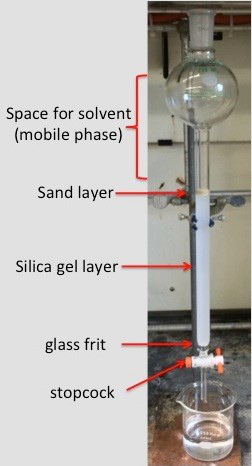JoVE Science Education
Organic Chemistry
Bu içeriği görüntülemek için JoVE aboneliği gereklidir.
Column Chromatography
Genel Bakış
Source: Laboratory of Dr. Jimmy Franco - Merrimack College
Column chromatography is one of the most useful techniques for purifying compounds. This technique utilizes a stationary phase, which is packed in a column, and a mobile phase that passes through the column. This technique exploits the differences in polarity between compounds, allowing the molecules to be facilely separated.1 The two most common stationary phases for column chromatography are silica gel (SiO2) and alumina (Al2O3), with the most commonly used mobile phases being organic solvents.2 The solvent(s) chosen for the mobile phase are dependent on the polarity of the molecules being purified. Typically more polar compounds require more polar solvents in order to facilitate the passage of the molecules through the stationary phase. Once the purification process has been completed the solvent can be removed from the collected fractions using a rotary evaporator to yield the isolated material.
Prosedür
1. Silica Gel Slurry
- Pour the silica gel into an Erlenmeyer flask. The weight of the packing material should be roughly 50x that of the sample being separated. If the compounds being separated have very similar Rf values, then it may require using a larger amount of silica per sample, which is the case in this example.
- Place 10 g of silica in the Erlenmeyer flask, since 50 mg of sample (45 mg of fluorenone and 5 mg of tetraphenylporphyrin) are being isolated.
Sonuçlar
The sample containing a mixture of tetraphenylporphyrin (TPP, 5 mg) and fluorenone (45 mg) has been successfully separated and each compound has been isolated. The TPP eluted first off the column as a dark purple-reddish band and the fluorenone subsequently eluted off the column as a yellow band (Figure 2). The eluted fractions were collected in test tubes and identified by their distinctive colors (Figure 3). The fractions containing the
Başvuru ve Özet
Summary
Column chromatography is a convenient and versatile method for purifying compounds. This method separates compounds based on polarity. By exploiting differences in the polarity of molecules, column chromatography can facilely separate compounds by the rate at which the compounds traverse through the stationary phase of the column. One of the benefits of column chromatography (especially when compared to recrystallization) is that very little about the compounds needs
Etiketler
Atla...
Bu koleksiyondaki videolar:

Now Playing
Column Chromatography
Organic Chemistry
360.9K Görüntüleme Sayısı

Katalize Giriş
Organic Chemistry
34.6K Görüntüleme Sayısı

Assembly of a Reflux System for Heated Chemical Reactions
Organic Chemistry
168.3K Görüntüleme Sayısı

Conducting Reactions Below Room Temperature
Organic Chemistry
70.7K Görüntüleme Sayısı

Schlenk Lines Transfer of Solvents
Organic Chemistry
41.7K Görüntüleme Sayısı

Degassing Liquids with Freeze-Pump-Thaw Cycling
Organic Chemistry
56.3K Görüntüleme Sayısı

Preparing Anhydrous Reagents and Equipment
Organic Chemistry
79.4K Görüntüleme Sayısı

Purifying Compounds by Recrystallization
Organic Chemistry
710.1K Görüntüleme Sayısı

Separation of Mixtures via Precipitation
Organic Chemistry
158.0K Görüntüleme Sayısı

Solid-Liquid Extraction
Organic Chemistry
238.1K Görüntüleme Sayısı

Rotary Evaporation to Remove Solvent
Organic Chemistry
213.0K Görüntüleme Sayısı

Fractional Distillation
Organic Chemistry
334.8K Görüntüleme Sayısı

Growing Crystals for X-ray Diffraction Analysis
Organic Chemistry
32.9K Görüntüleme Sayısı

Performing 1D Thin Layer Chromatography
Organic Chemistry
290.1K Görüntüleme Sayısı

Nuclear Magnetic Resonance (NMR) Spectroscopy
Organic Chemistry
248.9K Görüntüleme Sayısı
ISSN 2578-7918
JoVE Hakkında
Telif Hakkı © 2020 MyJove Corporation. Tüm hakları saklıdır
Sitemizdeki deneyiminizi iyileştirmek için çerezleri kullanıyoruz
Sitemizi kullanmaya devam ederek ya da "Devam et" butonuna tıklayarak, çerezleri kabul edebilirsiniz.
